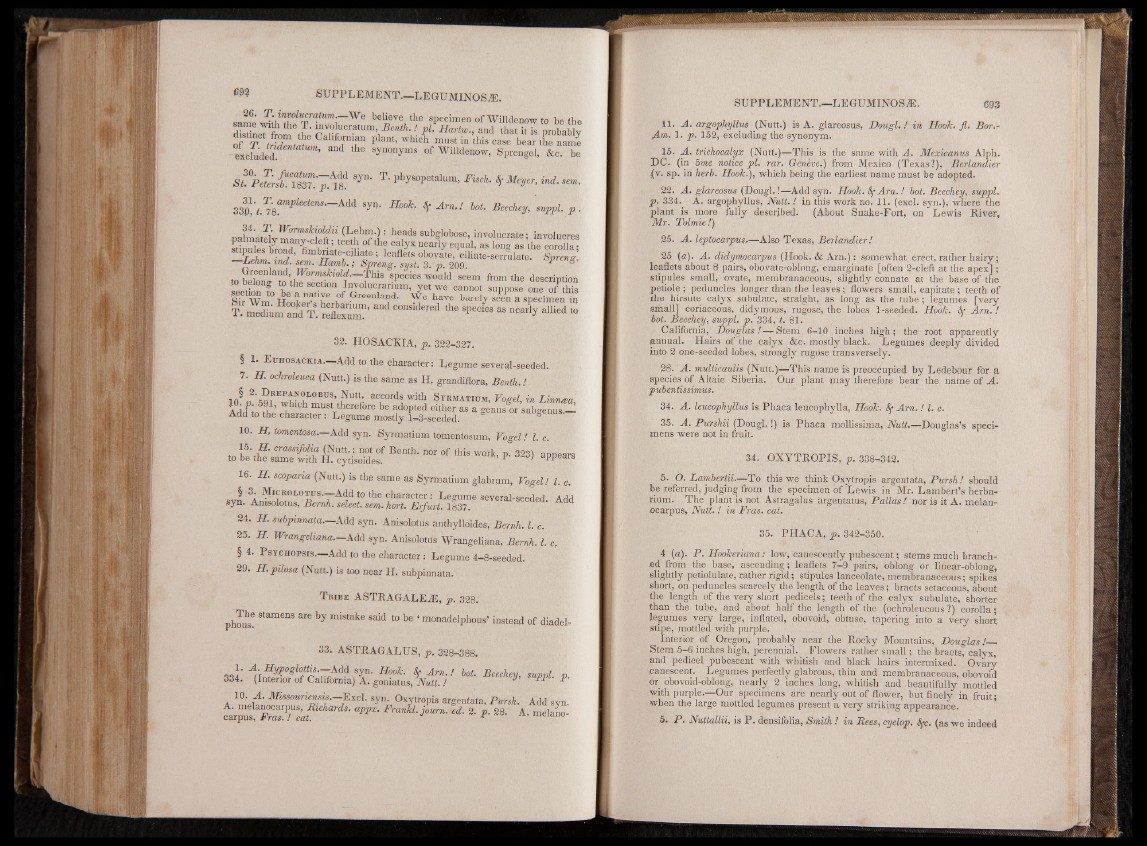
J * T-involucratum.—We believe the specimen of Willdenow to be the
S K f a distinct h-oSm^' tShe Californian plant, whicfhH mausmt in. , t hainsd c atshea tb heTars tphreo nbaabmlye
Im udt!ad tatUm' and thS synonyms of Wiildepow, Sprengel, &c. be
Syn' T - phyS0p6talum’ Fisch- 4 - ind. sem,
330,'t.^8am:PleCtenS‘~ M i Syn‘ H°°k - 4* Arn-! hot- Beechey, suppl. p .
Worriislcioldii (Lehm.) : heads subglobose, involucrate; involucres
pahnately many-cleft; teeth of the calyx nearly equal, as long as the cordla
TLAehem™.7 %r°n^dd. ’s efmim. bHSaartne.b'c.j;l laS£tper ’>e nlega. fsleytsst .o b3.o ypa.t e2,0 9ci.l iate-serruiate. Sp"r en°g,
to beT oT ^ta rr hiS Sp6CieS W° uld seem description
lection fo h e * Z ™^on ^olucranum, yet we cannot suppose one of this
ITr Wm I w L ’ T 5 Greenla?d' We have barely seen a specimen in
T. i i d T. m f l e ™ ’ “ C°nSldered SpedeS as nearly allied
32. HOSACKIA, p, 322-327.
§ L E uhosackia— Add to the character: Legume several-seeded.
7. H- ochroleuca (Nutt.) is the same as H, grandiflora, Benth,!
w K 2- £ r AuNT BVS’ ? m ; accords with Sybmatium, Vogel, in Linncea
Adiftn t l ’ 7 ^ most therefore be adopted either as a genus or subgenus ^ Add to the character: Legume mostly 1-3-seeded. ..
10. H, tomentosa.—Add syn. Syrmaflum tomentosum, Vogel! 1. c.
t crassif olf (Nutt,; not of Benth. nor of this work, p. 3231 appears
to be the same with H. eyflsoides, ’ 1 > aPPear8
16. H. scopana (Nutt.) is the same as Syrmaflum. glabrum, Vogel! 1. c.
$ 3: MtcaonoTug.—Add to the character : Legume several-seeded. Add
syn. Amsolotus, Bernh. select, sem• hart. Erfurt. 1837. ’
24. H. subpinnata— Add syn. Anisolptus anthylloides, Bernh. 1. c.
25. H. Wrangehana— Add syn. Anisolotus Wrangeliana, Bernli. 1. c,
§ 4. P s y c h o p s is . Add to the character : Legume 4-8-seeded.
29. H. pilosa (Nutt.) is too near H. subpinnata.
T r ib e ASTRAGALEiE, p . 328.
phous? StamenS are by mistake said to be ‘ monadelphous’ instead of diadel-
33. ASTRAGALUS, p. 328-388,
J r ^ y p o g l f i s .-A d d syn. Hook, Sp A m .! bot. Beechey, suppl. p.
334. (Interior of California) A. goniat.us, Nutt.! J F
A “d l . i f ^ rissounef - f f —:Excl- syn- Oxytropis argentata, Pursh. Add syn.
A. melanocarpus, Richards, appx. Frahkl. journ. ed. 2. p. 28. A. melano-
carpus, Eras.! cat. 1 mcwiJU
11. A. argophyllus (Nutt.) is A. glareosus, Dougl. ! in Hook. fl. Bor.-
Am. 1. p. 152, excluding the synonym.
15. A. trichocalyx (Nutt.)—This is the same with A. Mexicanus Alph.
DC. (in ome notice pi. rar. Genève,) from Mexico (Texas?), Berlandier
(v. sp. in herb. Hook.), which being the earliest name must be adopted.
22. A. glareosus (Dougl. !—Add syn. Hook. Sp Arn. ! bot. Beechey, suppl.
p. 334. A. argophyllus, Nutt. ! in this work no. 11. (excl. syn.), where the
plant is more fully described. (About Snake-Fort, on Lewis River,
Mr. Tolmie!)
25. A. leptocarpus.—Also Texas, Berlandier !
25 (a). A. didymocarpus (Hook. & Arn.) : somewhat erect, rather hairy ;
leaflets about 8 pairs, obovate-oblong, emarginate [often 2-cleft at the apex] ;
stipules small, ovate, membranaceous, slightly connate at the base of the
petiole ; peduncles longer than the leaves ; flowers small, capitate ; teeth of
the hirsute calyx subulate, straight, as long as the tube ; legumes [very
small] coriaceous, didymous, rugose, the lobes 1-seeded. Hook. Sp A m .!
bot. Beechey, suppl. p. 334, t. 81.
California, Douglas !—- Stem 6—10 inches high; the root apparently
annual. Hairs of the calyx &c. mostly black. Legumes deeply divided
into 2 one-seeded lobes, strongly rugose transversely.
28. A. multicaulis (Nutt.)—This name is preoccupied by Ledebour for a
species of Altaic Siberia. Our plant may therefore bear the name of A.
pubentissimus.
34. A. leucophyllus is Phaca leucophylla, Hook. Sp Arn. ! 1. c.
35. A. Purshii (Dough !) is Phaca mollissima, Nutt.—Douglas’s specimens
were not in fruit.
34. OXYTROPIS, p, 338-342.
5. O. Lambertii.—To this we think Oxytropis argentata, Pursh ! should
be referred, judging from the specimen of Lewis in Mr. Lambert’s herbarium.
The plant is not Astragalus argentatus, Pallas ! nor is it A. melanocarpus,
Nutt. ! in Fras. cat.
35. PHACA, p. 342-350.
4 (a). P. Hookeriana: low, eanescently pubescent ; stems much branched
from the base, ascending; leaflets 7-9 pairs, oblong or linear-oblong,
slightly petiolulate, rather rigid; stipules lanceolate, membranaceous; spikes
short, on peduncles scarcely the length of the leaves; bracts setaceous, about
the length of the very short pedicels ; teeth of the calyx subulate, shorter
than the tube, and about half the length of the (ochroleucous ?) corolla ;
legumes very large, inflated, obovoid, obtuse, tapering into a very short
Stipe, mottled with purple. :
Interior of Oregon, probably near the Rocky Mountains, Douglas!__
Stem 5-6 inches high, perennial. Flowers rather small ; the bracts) calyx,
and pedicel pubescent with whitish and black hairs intermixed. Ovary
panescent. Legumes perfectly glabrous, thin and membranaceous, obovoid
or obovoid-oblong, nearly 2 inches long, whitish and beautifully mottled
with purple.—Our specimens are nearly out of flower, but finely in fruit;
when the large mottled legumes present a very striking appearance.
fl- B. Nuttallii, is P . densifolia, Smith ! in Rees, cyclop. Spc. (as we indeed